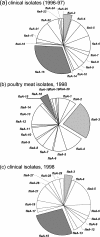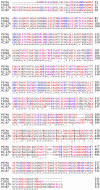Epidemiology, relative invasive ability, molecular characterization, and competitive performance of Campylobacter jejuni strains in the chicken gut
- PMID: 17921281
- PMCID: PMC2168142
- DOI: 10.1128/AEM.01657-07
Epidemiology, relative invasive ability, molecular characterization, and competitive performance of Campylobacter jejuni strains in the chicken gut
Abstract
One hundred forty-one Campylobacter jejuni isolates from humans with diarrhea and 100 isolates from retailed poultry meat were differentiated by flaA typing. The bacteria were isolated in a specific geographical area (Dunedin) in New Zealand over a common time period. Twenty nine flaA types were detected, one of which (flaA restriction fragment length polymorphism type 15 [flaA-15]) predominated among isolates from humans ( approximately 30% of isolates). This strain was of low prevalence (5% of isolates) among poultry isolates. flaA-15 strains were five to six times more invasive of HEp2 cells in an in vitro assay than a flaA type (flaA-3) that was commonly encountered on poultry meat (23% of isolates) but was seldom associated with human illness (5%). Competitive-exclusion experiments with chickens, utilizing real-time quantitative PCR to measure the population sizes of specific strains representing flaA-15 (T1016) and flaA-3 (Pstau) in digesta, were carried out. These experiments showed that T1016 always outcompeted Pstau in the chicken intestine. Genomic comparisons of T1016 and Pstau were made using DNA microarrays representing the genome of C. jejuni NCTC 11168. These comparisons revealed differences between the strains in the gene content of the Cj1417c-to-Cj1442c region of the genome, which is associated with the formation of capsular polysaccharide. The strains differed in Penner type (T1016, O42; Pstau, O53). It was concluded that poultry meat was at least one source of human infection with C. jejuni, that some Campylobacter strains detected in poultry meat are of higher virulence for humans than others, and that bacterial attributes affecting strain virulence and commensal colonization ability may be linked.
Figures



Similar articles
-
Molecular diversity of Campylobacter coli and C. jejuni isolated from pigs at slaughter by flaA-RFLP analysis and ribotyping.J Vet Med B Infect Dis Vet Public Health. 2002 Oct;49(8):388-93. doi: 10.1046/j.1439-0450.2002.00595.x. J Vet Med B Infect Dis Vet Public Health. 2002. PMID: 12449248
-
Evaluation of whole-genome sequencing as a genotyping tool for Campylobacter jejuni in comparison with pulsed-field gel electrophoresis and flaA typing.Poult Sci. 2013 Feb;92(2):573-80. doi: 10.3382/ps.2012-02695. Poult Sci. 2013. PMID: 23300325
-
Risk factors for infection with Campylobacter jejuni flaA genotypes.Epidemiol Infect. 2008 Nov;136(11):1480-91. doi: 10.1017/S0950268807000246. Epub 2008 Jan 21. Epidemiol Infect. 2008. PMID: 18205975 Free PMC article.
-
Campylobacter jejuni transducer like proteins: Chemotaxis and beyond.Gut Microbes. 2017 Jul 4;8(4):323-334. doi: 10.1080/19490976.2017.1279380. Epub 2017 Jan 12. Gut Microbes. 2017. PMID: 28080213 Free PMC article. Review.
-
Colonization properties of Campylobacter jejuni in chickens.Eur J Microbiol Immunol (Bp). 2012 Mar;2(1):61-5. doi: 10.1556/EuJMI.2.2012.1.9. Epub 2012 Mar 17. Eur J Microbiol Immunol (Bp). 2012. PMID: 24611122 Free PMC article. Review.
Cited by
-
Autoinducer-2 production in Campylobacter jejuni contributes to chicken colonization.Appl Environ Microbiol. 2009 Jan;75(1):281-5. doi: 10.1128/AEM.01803-08. Epub 2008 Nov 14. Appl Environ Microbiol. 2009. PMID: 19011073 Free PMC article.
-
Hypoacylated LPS from Foodborne Pathogen Campylobacter jejuni Induces Moderate TLR4-Mediated Inflammatory Response in Murine Macrophages.Front Cell Infect Microbiol. 2018 Feb 27;8:58. doi: 10.3389/fcimb.2018.00058. eCollection 2018. Front Cell Infect Microbiol. 2018. PMID: 29535976 Free PMC article.
-
Extensive characterization of Campylobacter jejuni chicken isolates to uncover genes involved in the ability to compete for gut colonization.BMC Microbiol. 2015 May 10;15:97. doi: 10.1186/s12866-015-0433-5. BMC Microbiol. 2015. PMID: 25958385 Free PMC article.
-
Serotonin modulates Campylobacter jejuni physiology and invitro interaction with the gut epithelium.Poult Sci. 2021 Mar;100(3):100944. doi: 10.1016/j.psj.2020.12.041. Epub 2021 Jan 5. Poult Sci. 2021. PMID: 33652538 Free PMC article.
-
Effects of dietary chlorogenic acid on cecal microbiota and metabolites in broilers during lipopolysaccharide-induced immune stress.Front Microbiol. 2024 Mar 8;15:1347053. doi: 10.3389/fmicb.2024.1347053. eCollection 2024. Front Microbiol. 2024. PMID: 38525083 Free PMC article.
References
-
- Allos, B. M. 2001. Campylobacter jejuni infections: update on emerging issues and trends. Clin. Infect. Dis. 32:1201-1206. - PubMed
-
- Bacon, D. J., C. M. Szymanski, D. H. Burr, R. P. Silver, R. A. Alm, and P. Guerry. 2001. A phase-variable capsule is involved in virulence of Campylobacter jejuni 81-176. Mol. Microbiol. 40:769-777. - PubMed
-
- Barrow, P., and K. Page. 2000. Inhibition of colonisation of the alimentary tract of young chickens with Campylobacter jejuni by pre-colonisation with strains of C. jejuni. FEMS Microbiol. Lett. 182:87-91. - PubMed
-
- Bodenteich, A. S., Y. Chisoe, F. Wang, and B. A. Roe. 1994. Shotgun cloning as the strategy of choice to generate templates for high throughput dideoxynucleotide sequencing, p. 42-50. In M. D. Adams, C. Fields, and C. Venter (ed.), Automated DNA sequencing and analysis techniques. Academic Press, London, United Kingdom.
Publication types
MeSH terms
Substances
LinkOut - more resources
Full Text Sources
Medical
Molecular Biology Databases

